Royal Gaitor is not one of the popular tourist places to visit in Jaipur among travelers; it’s one of the hidden places in Jaipur. I have never been able to completely comprehend the reasons for apathy among travelers for Gaitore. You can find my thoughts as to why it doesn’t figure in the Jaipur sightseeing map at the end of this blog. Locals call this place Gaitor Ki Chhatriyan.
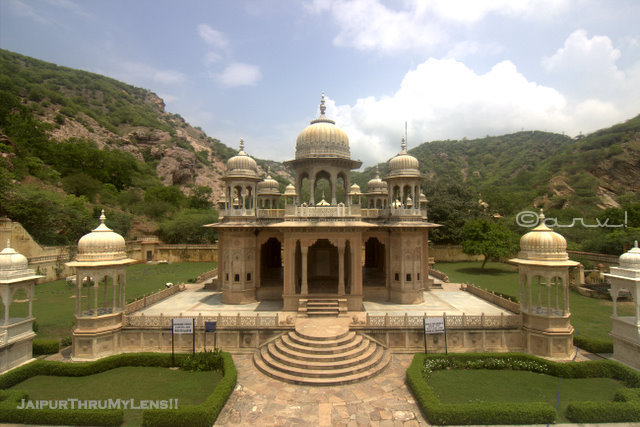
Interestingly, a few western travelers have mentioned visiting Gaitor during their travel in the 18th and 19th centuries. One such travel account can be found in “Handbook of the Punjab, western Rajputana, Kashmir, and upper Sindh”, John Murray published in London, in 1883 AD. This book was authored by Edward B. Eastwick and intended to be a travel guide for western travelers (especially British). In a way, it is one of the early travel guides in India, especially in Jaipur.
“The next visit will be to the chhatris or cenotaphs of the Maharajas at Gethur. This on N.E. of the city wall. The traveler will drive to near the wall of the old city Brahmpur, and then ride on an elephant to the gate of Gethur, but then he will have to dismount and walk about 100 yds. The Chhatris are in well-planted gardens, the trees of which are full of solemn-looking grey-headed monkeys, and tigers are sometimes seen on the hill above. This is not far off a paved road that leads to Nahargarh….”
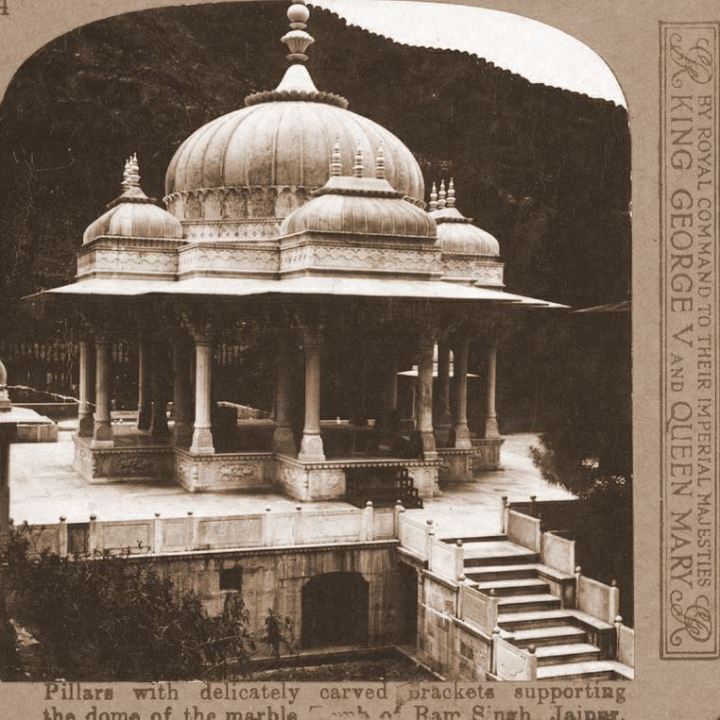
A Detailed Guide on Gaitore in Jaipur
Early Jaipur travelogues mentioning Royal Gaitor as a place to visit in Jaipur is not surprising. Royal Gaitor is one of the most magnificent specimens of Jaipur architecture. I have been to Gaitor on a previous occasion, three years ago. You can find it in this blog Royal Gaitor | The Rajput Architectural Opulence!
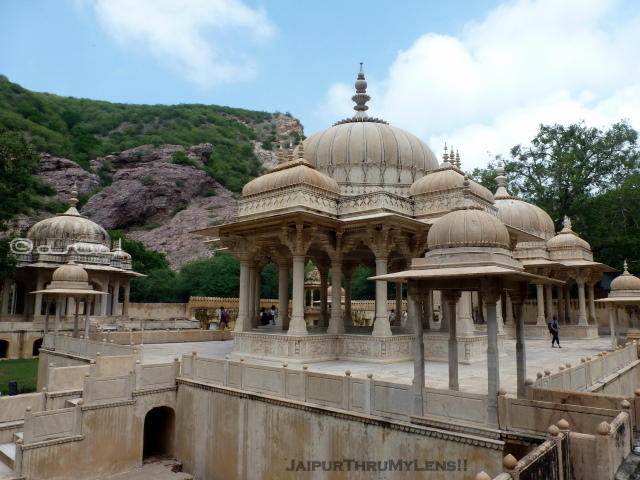
The ownership of Gaitor rests with the descendants of the princely family since these are Chhatris or tombs of erstwhile rulers. This place includes three sections with the oldest section being farthest from the entrance. It houses the tombs of Maharaja Sawai Jai Singh II, the first king of Jaipur till Maharaja Sawai Ram Singh II. Succeeding rulers built commemorative Chhatris.
What is Chhatri?
Chhatris are semi-open canopies. Read the in-depth post – Chhatris| Jaipur architecture style
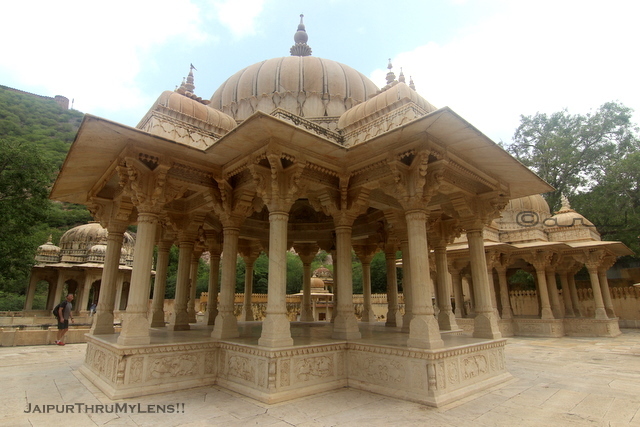
Maharaja Sawai Jai Singh II
The Chhatri of Maharaja Sawai Jai Singh II is the most beautiful and ornamental having exquisite carvings and workmanship on white Makrana marble. Makrana marble is considered to be one of the best white marble around. It includes no grains and is ideal for carvings. Sawai Ishwari Singh, the succeeding ruler built this tomb.
This Chhatri has 20 pillars, and the central dome is supported by an octagon; the flower remains a dominant theme in this Chhatri as evident from the carvings. The bracket supporting the roof is carved in the shape of an elephant trunk and features a lotus flower at the bottom. The pillars have lotus petals at both ends -the pedestal and ceiling.
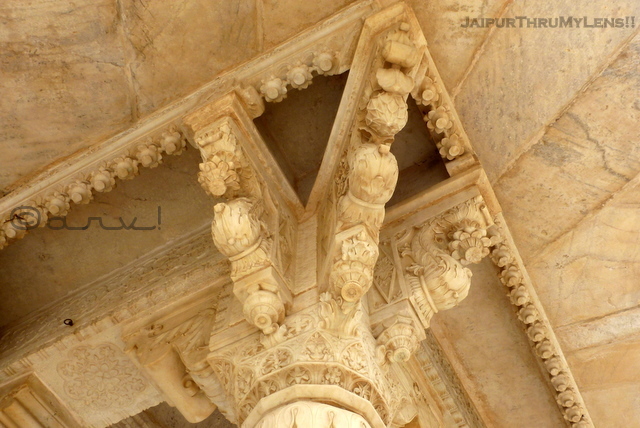
Apsara can be seen inside each of the domes on pillars. There are exquisite carvings inside the cornice from Hindu mythology featuring Rama, Krishna, Sheshnag, Samudra Manthan, and so on.

The plinth or stylobate depicts elephants and horses with warriors, possibly a war scene. The reason for featuring them in this Chhatri speaks a lot about Maharajah Sawai Jai Singh II’s life. He was a Mansabdaar in the Mughal court and fought many wars and governed the state of Malwa for 13 years. Historians consider him for being a far-sighted, clever, and daunting ruler.
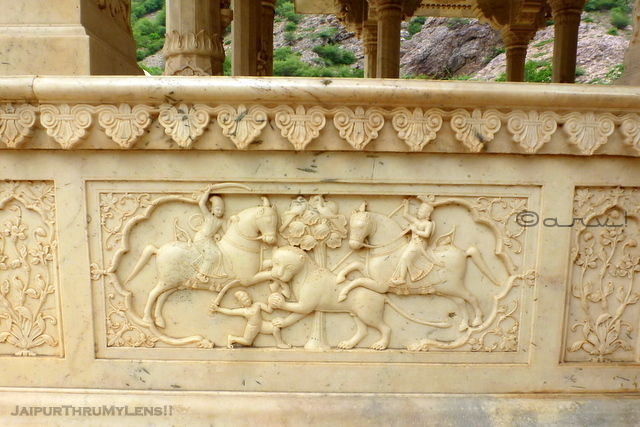
Maharaja Ram Singh II’s
Maharaja Ram Singh II’s Chhatri is placed behind Maharajah Sawai Jai Singh II’s chhatri. Both Chhatris are identical. This is something unique; all other structures are unrepeated as far as design elements are considered. Among the Jaipur rulers from the 18th and 19th centuries, three of them were remarkable.
Maharajah Sawai Jai Singh II, the founder of Jaipur requires no introduction. Maharajah Ram Singh II’s rule is synonymous with Ram Rajya. He was a competent administrator, and reformer, and provided an impetus for the advancement of the state and its people. Maharajah Sawai Pratap Singh is fondly remembered for his contribution to architecture, art, and religion. He commissioned the construction of the Hawa Mahal, which is synonymous with Jaipur.
Maharajah Ram Singh II’s ascend to power restored the glory days of Maharajah Sawai Jai Singh II’s rule. It goes without saying, this is just a theory that many believe in.
Another important Chhatri in this section is Sawai Madho Singh I. It is elementary in design. Maharaja Sawai Pratap Singh commissioned this Chhatri.
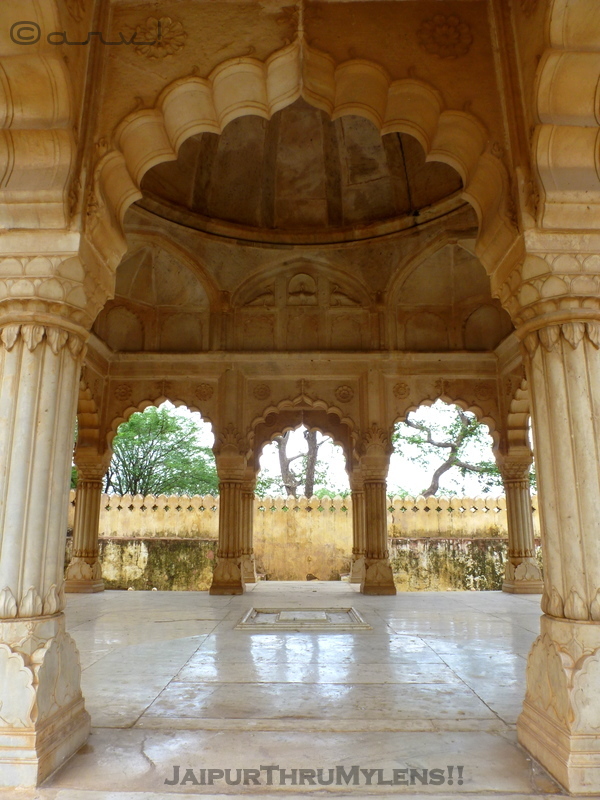
What seems to be the reasons? Presumably, it indicates the financial status of the state. There were many wars with Marathas during the reign of Maharajah Sawai Pratap Singh. Many historians concur Marathas were mercenaries and constant payments in lieu of peace depleted the treasure of the Jaipur kingdom. Despite the simplicity, there are decorative carvings and intricate design elements in this Chhatri.
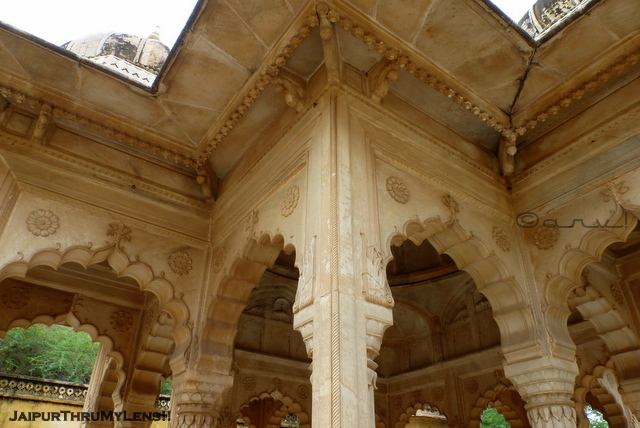
There are two smaller Chhatris placed in this compound. One is Sawai Prithvi Singh II and Sawai Jagat Singh II. It is assumed small Chhatris indicate their brief tenures.
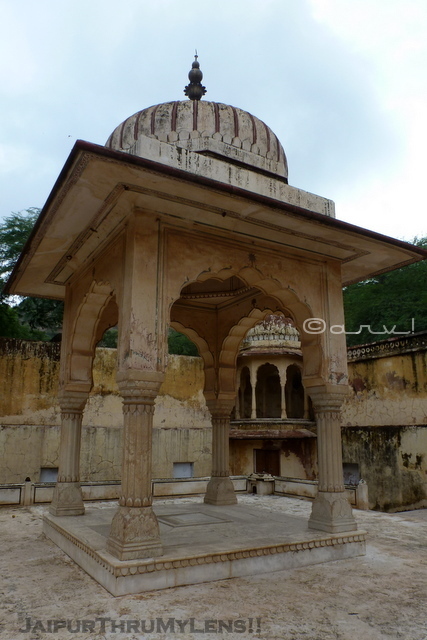
Maharaja Sawai Pratap Singh
The last Chhatri that needs a mention is that of Maharaja Sawai Pratap Singh. It is placed on the left side of the entrance having a backdrop of Nahargarh Fort and hills. This structure too is akin to the one of Sawai Madho Singh I. The primary theme in the detailing represents his love for Krishna.
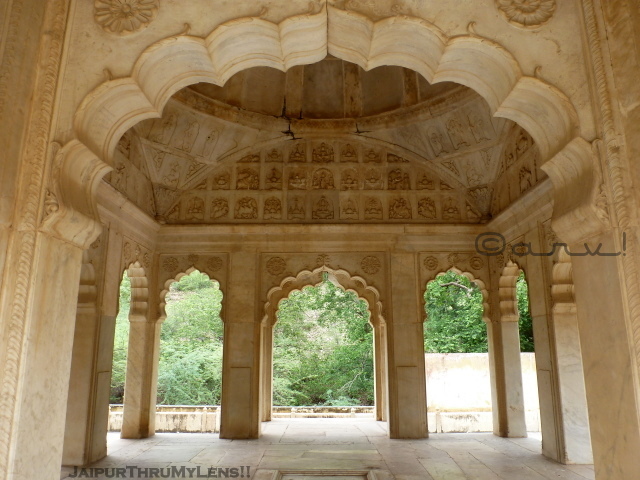
Upon exiting this complex and moving to the middle section one discovers a Shiva temple, a large ficus tree, and a flat Pavillion. This is the smallest of all three sections and contains just one structure.
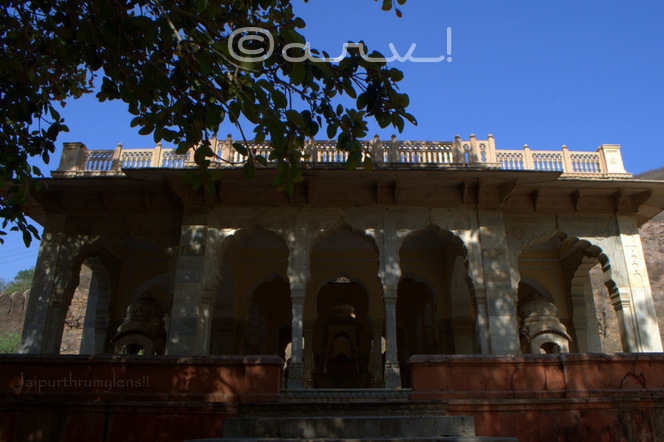
Maharaja Sawai Madho Singh II
Placed here are a couple of small Chhatris dedicated to the numerous sons of Sawai Madho Singh II; it’s a peculiar case since it doesn’t commemorate any king. Many Jaipur rulers adopted sons like Maharajah Sawai Ram Singh II, Sawai Madho Singh II, and Sawai Man Singh II. Not producing an heir raised the question of potency or manhood among the public. It was a norm for Jaipur kings to have multiple wives, mistresses, and concubines; Sawai Madho Singh II was known to have the largest harem. Regrettably, he did not produce any son to succeed him, despite many children from concubines and mistresses. This Chhatri quelled the questions of his potency.

From the midsection, one needs to retrace to the third part of the Royal Gaitor which has three tombstones. Two of these belong to the last two rulers Sawai Madho Singh II and Sawai Man Singh II. The last one belongs to the son of Sawai Man Singh II – Brig. Bhawani Singh.

Sawai Madho Singh II’s tomb is the largest of all structures in Gaitore; it’s constructed from sandstone, unlike others that use marble. It has exquisite carvings and a strong European flavor. He was the first Jaipur ruler to travel to England in 1902 to attend the coronation ceremony of King Edward VII. He traveled with a massive gathering which included many support staff in a specially booked steamer, SS Olympia. Among the things he carried were an idol of Krishna and 8,000 liters of Ganga Jal (water of the river Ganga) in silver urns. These silver urns are on display in Jaipur City Palace.
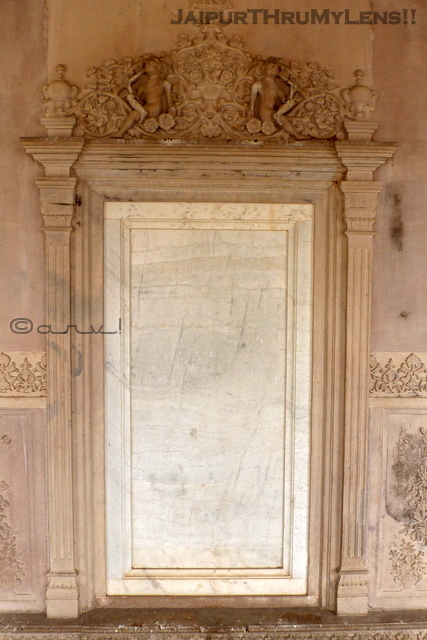
Sawai Man Singh II built his Chhatris. It is a coincidence that both Sawai Madho Singh II and Man Singh II were adopted and were from Isarda near Jaipur. Some historians concur it is likely this connection led to the building of such grand tombs. This is a controversial theory that others might not accept.
Maharaja Sawai Man Singh II
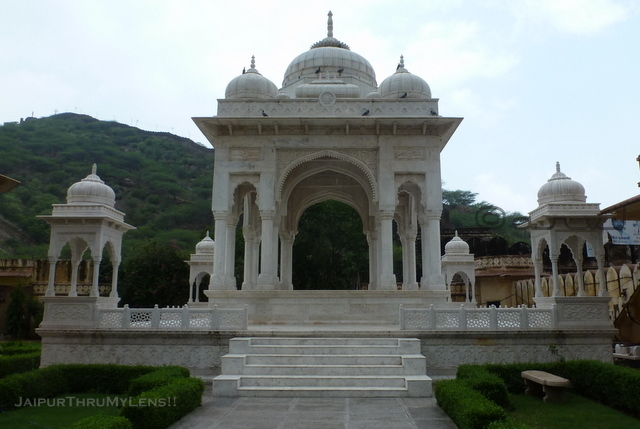
The other two Chhatris belonging to Maharaja Sawai Man Singh II and Sawai Bhawani Singh are simpler and smaller in size. However, the plinth section incorporates a few more meticulous details about their personas, like the love for polo or the initials.
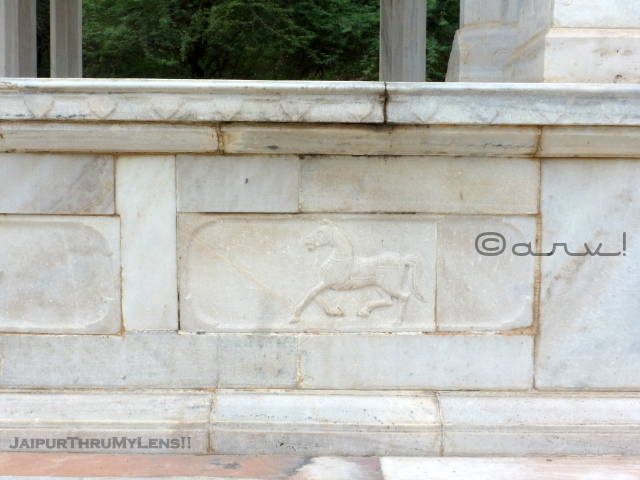
Why is Gaitor one of the offbeat tourist attractions of Jaipur?
Descendants of the erstwhile Jaipur rulers never promoted Gaitore among travelers and tourists. While the maintenance is not unacceptable but it is not managed at par with some of their other tourist attractions like Jaipur City Palace or Jaigarh Fort.
This place has no guides or audio guides for tourists. Many times, the tuk-tuk drivers double up as a guide. Even the tombs are unmarked. It is not uncommon to find street dogs lazing around in the compound.
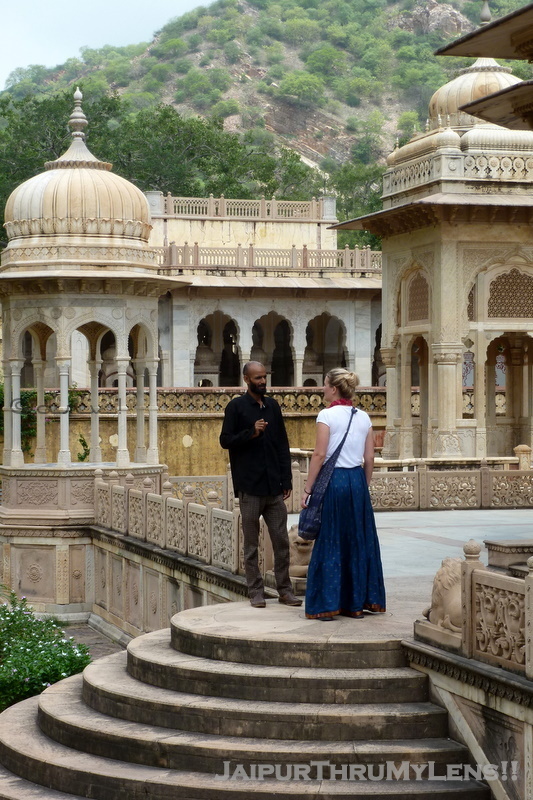
One of the reasons Gaitor doesn’t receive too many tourists is that it is far away from the main tourist areas of Jaipur. It seems people connected with Jaipur tourism are not keen to promote Gaitore. Amer Fort/ Nahargarh Fort and Jaipur City Palace complex are the two most visited tourist areas. Reaching Gaitor from either is not easy, one needs to traverse through congested roads of Brahampuri. It needs to be mentioned, the Gaitor cenotaphs are one of the historical places in Jaipur full of history and beautiful architecture.

I’m unsure if this is a blessing in disguise.
Royal Gaitore Location
Gaitore is located at the farthest end of Brahampuri in Jaipur with Garh Ganesh Temple on the east and Nahargarh Fort on the west.
Royal Gaitore Timing
Gaitore is open from 10 AM to 5 PM. I prefer a visit in the morning because it provides a good amount of sunlight conducive for studying the carvings and detailing on the stone surface. Some people advocate the evening as well.
Royal Gaitore Entrance Free
The Gaitore entry fee is Rs 30 per person. It is also part of the composite ticket being sold by Jaipur City Palace costing Rs 300 per person for Indians and includes entry to Jaipur City Palace, Jaigarh Fort, Gaitore, and Maharani Ki Chhatriyan on Amer Road.
Things to see at Royal Gaitore
There are beautiful tombs/ mausoleums of erstwhile Jaipur rulers in Gaitor. Many travelers visit this place for clicking pictures for Instagram, so in a way, this is one of the Instagram-worthy places in Jaipur. On the other hand, many travelers love to sit here and soak in the tranquil atmosphere of Gaitore. If you love art, architecture, and history Gaitore is worth visiting. A few female travelers I met confessed they enjoy the serene and peaceful atmosphere as a welcome break from all the cacophony on the streets of Jaipur.
You can also visit Garh Ganesh Temple along with Royal Gaitore

Follow Jaipurthrumylens on Facebook Twitter Instagram
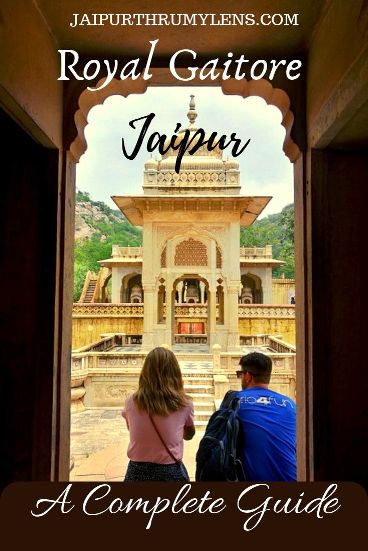
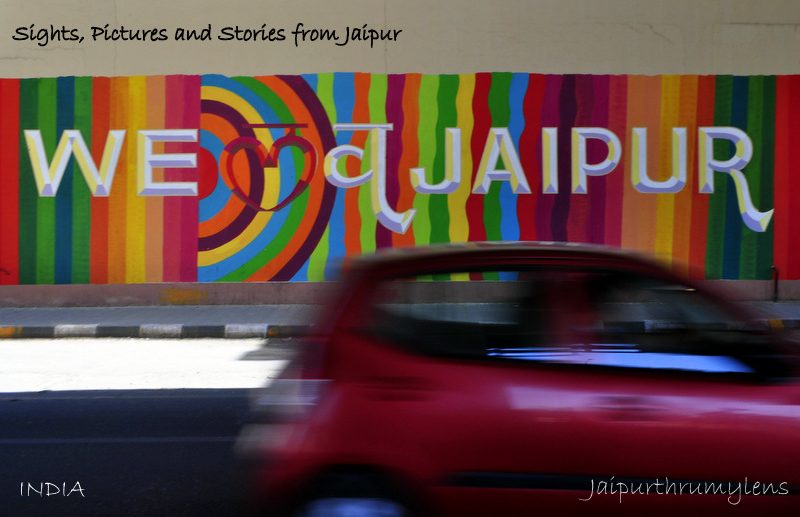
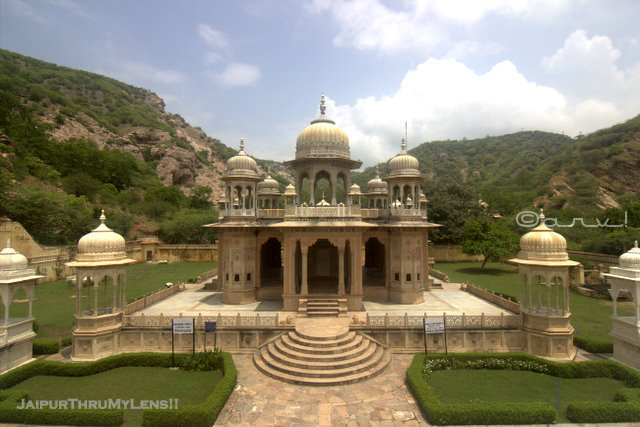
Such an interesting post, Arv – I love the historical info alongside the wonderful architecture. Your photos are simply stunning and get better all the time! C x
LikeLiked by 1 person
Thanks, Claire for a making my day. I’m happy you enjoy these pictures. It is a great incentive. Hope you are doing well? You have been missing in action. Are you better now?
LikeLiked by 1 person
I never have wanted to travel to that part of the world, but your post makes me want to go there soon. Thanks for the great article!
LikeLiked by 1 person
Happy to hear that this post inspired you. Just curious to know why you never wanted to travel to this part of the world.
LikeLike
I love how passionate you are about Jaipur, and the multitude of resources you have produced on it is super helpful for travellers headed that way!
LikeLiked by 1 person
Thanks, Sheryl. It just flows on it’s own. It’s good to hear that it’ll be of great help for the travellers.
LikeLiked by 1 person
Wow Arv. What an inspired place.
Ryan
LikeLike
Love your images, may I ask which watermark download you use please.
LikeLiked by 1 person
Happy to hear this, Justine. It is Castellar.
LikeLike
Thanks for that 👌
LikeLiked by 1 person
🙂
LikeLike
Thank you for this insightful article. I wish I had seen it before visiting the site. In a way, I am glad there were so few people there, as it lent a calm beauty to the site. Your article was like a key fitting in a lock.
The carvings are exquisite and the architecture magnificent. Thank you again.
LikeLiked by 1 person
I’m glad you liked it
LikeLike